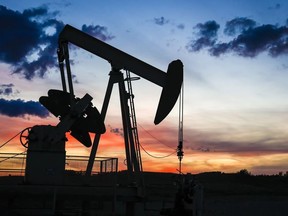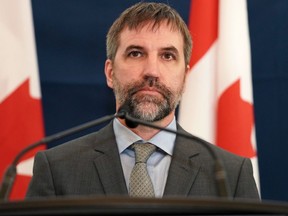‘They’re large numbers. And we have been attempting to make the case to Ottawa that when Alberta does effectively, Canada does effectively,’ Premier Danielle Smith mentioned Wednesday

Article content material
It’s no shock the Alberta authorities and the nation’s oil and fuel trade fiercely oppose the Trudeau authorities’s incoming cap on greenhouse fuel emissions from the sector, highlighted by new submissions to Ottawa this week.
However in the event you dive into the province’s report filed with the federal authorities, it consists of some new financial evaluation that helps clarify why they’re so involved.
Commercial 2
Article content material
Article content material
A forecast by the Convention Board of Canada on the potential fallout of the federal coverage — contained in Alberta’s 24-page submission — underscores what it calls the “extreme unfavourable impacts,” together with:
- 82,000 to 151,000 jobs misplaced by the top of the last decade throughout the nation, together with between 54,000 and 91,000 in Alberta;
- Nominal gross home product (GDP) in Canada decreased cumulatively between $600 billion and $1 trillion from 2030 to 2040. Alberta’s GDP would decline by 3.8 per cent in that interval;
- Alberta authorities revenues chopped by $73 billion to $127 billion within the subsequent decade, whereas federal revenues tumble between $84 billion and $151 billion.
“They’re large numbers. And we have been attempting to make the case to Ottawa that when Alberta does effectively, Canada does effectively,” Premier Danielle Smith mentioned Wednesday in an interview.
“I’m hoping that self-interest kicks in right here in some unspecified time in the future . . . There’s no cause for them to attempt to kneecap our trade. It simply hurts everybody.”
The evaluation provides extra ammunition to an acrimonious debate between the federal and provincial governments over the coverage, which is a part of Canada’s broader local weather plan to achieve net-zero emissions by 2050.
Article content material
Commercial 3
Article content material
The Convention Board research was commissioned by the province, with work performed by the think-tank over the previous two months.
That’s a part of what makes it so fascinating, because it’s primarily based on the brand new framework for the oilpatch emissions cap launched by the Trudeau authorities in December.
“The coverage, because it’s introduced proper now, in our view goes to result in considerably slower development of the oil and fuel sector, throughout the nation and materially in Alberta,” mentioned the board’s director of financial analysis, Tony Bonen.
“And it comes at a reasonably excessive price, when it comes to the price-per-megatonne of greenhouse fuel emissions which are decreased.”
Really helpful from Editorial
-

’Not be tolerated’: Alberta information formal response to proposed oilsands emissions cap
-

Alberta gearing up for one more court docket battle over Ottawa’s oil, fuel emissions cap
-

Varcoe: ‘Unworkable, untenable’ — Alberta enterprise leaders need Ottawa to scrap Canada’s oil and fuel emissions cap
-

‘An intentional assault’: Alberta reacts to new federal oil and fuel emissions cap
-

Would Alberta win a court docket battle over the emissions cap? What’s a cap-and-trade system? This is what you could know
Commercial 4
Article content material
The report regarded on the penalties for oil and fuel manufacturing if the deliberate federal emissions targets for the sector usually are not achieved by 2030 — significantly authorities assumptions surrounding technological and effectivity positive aspects — resulting in assumed output cuts.
Whereas the trade can take lower-cost steps to decrease its methane emissions, there would nonetheless be a niche to fulfill Ottawa’s objective for the oilpatch.
That may result in decreased manufacturing development — down about 11 per cent from the Convention Board’s base case — as oil and fuel “will get left within the floor,” subsequent decade, Bonen mentioned.
“Some greater price, much less economically environment friendly, tasks is not going to transfer ahead in our state of affairs. And a few which are working now, however at a better price, are most likely stopped. However there’ll nonetheless be internet new wells drilled and new manufacturing produced.”
(The information is predicated on the board’s most certainly state of affairs, as two different ones it examined confirmed a better impact on jobs and GDP.)
Bonen estimated the prices of reducing emissions by manufacturing cuts at about $1,600 to $1,700 for each megatonne decreased by the cap.
Commercial 5
Article content material
Beneath its forecast, the cap would result in a everlasting one-time lower in Canadian GDP of 0.9 per cent between 2030 and 2040.
“We’re going to require substantial adjustments to our financial techniques to handle the local weather disaster,” Bonen added.
“For us, it’s crucial to be clear on the place these impacts are going to be felt and be trustworthy concerning the dimension of these impacts — so we will begin adjusting and planning forward for them.”

The provincial submission additionally referred to as on the federal authorities to launch its evaluation of the financial results of the cap from 2030 ahead.
That’s coming “and will likely be out there when the federal government publishes draft (cap) laws later this yr,” a spokesperson for federal Surroundings Minister Steven Guilbeault mentioned in an e mail.
“The actual fact is, a cap on oil and fuel emissions is sensible financial coverage — it is going to assist make sure the sector’s long-term competitiveness in a quickly decarbonizing world.”
The oil and fuel trade is the biggest emitting sector in Canada. The Liberal authorities has launched a collection of insurance policies — together with a nationwide worth on carbon, clear gas laws and the incoming emissions cap — as issues round local weather change mount.
Commercial 6
Article content material
The federal cap seeks to decrease trade emissions by 35 to 38 per cent by the top of the last decade from 2019 ranges. Some flexibility measures, akin to letting corporations purchase offset credit or contribute to a decarbonization fund, may shrink it to twenty per cent.
The cap is anticipated to be phased in between 2026 and 2030.
Canada is the world’s fourth-largest oil producer and the sector straight employed 178,000 individuals throughout the nation in December.

The provincial submission says the cap may also have an effect on the Canadian building, manufacturing and repair sectors, in addition to the monetary, restaurant and hospitality industries.
College of Calgary economist Trevor Tombe mentioned there are too many unanswered questions concerning the cap to completely perceive the financial penalties of the coverage.
However he mentioned it’s clear the impact will likely be important, hitting one area of the nation a lot more durable than the remainder.
“Whether or not it’s $600 billion to $1 trillion, because the Convention Board places it out, or another set of numbers, it’s going to be large — that’s the takeaway from these numbers,” Tombe mentioned.
Commercial 7
Article content material
Business teams are united of their opposition to the cap, calling for it to be scrapped.
The Pathways Alliance group, which represents giant oilsands operators, maintains the cap is pointless and unworkable, saying it is going to deter traders from the sector and it dangers curbing manufacturing.
The group is working to achieve net-zero emissions by 2050 and is growing a $16.5-billion carbon seize and storage community in Alberta.
“I might say (the cap) is singularly unhelpful in advancing decarbonization funding of any type, together with the Pathways mission. Sadly, all it does is ship a message to traders that Canada shouldn’t be open for enterprise,” Pathways Alliance president Kendall Dilling mentioned in an interview.
“At this level, in good religion, we are going to maintain our heads down, maintain investing, maintain working and belief that sanity will prevail.”
In its submission, the Canadian Affiliation of Petroleum Producers (CAPP) famous emissions from the standard oil and fuel sector fell by 24 per cent, whereas manufacturing grew by 21 per cent between 2012 and 2021.
“We hope that this framework is placed on ice, in order that we will actually have a look at this thoughtfully and realistically,” mentioned CAPP president Lisa Baiton.
Chris Varcoe is a Calgary Herald columnist.
Article content material





